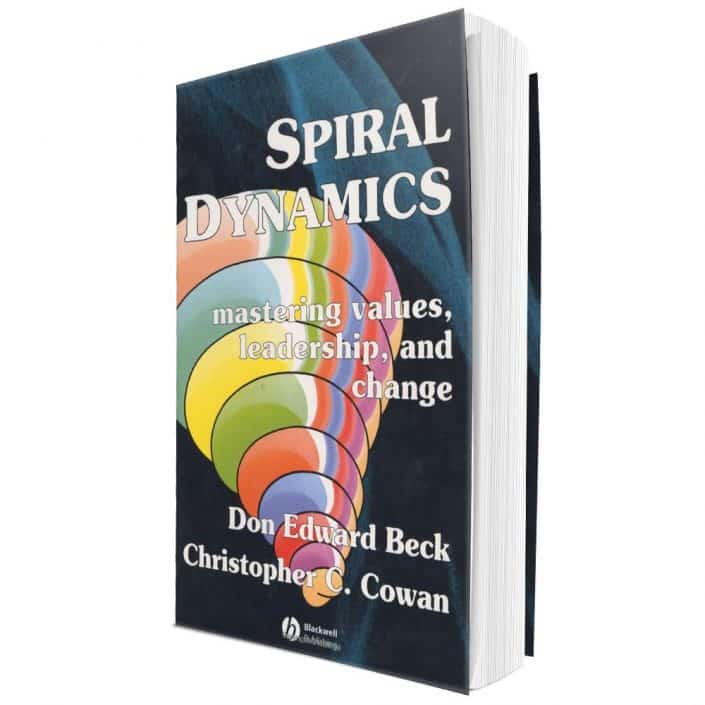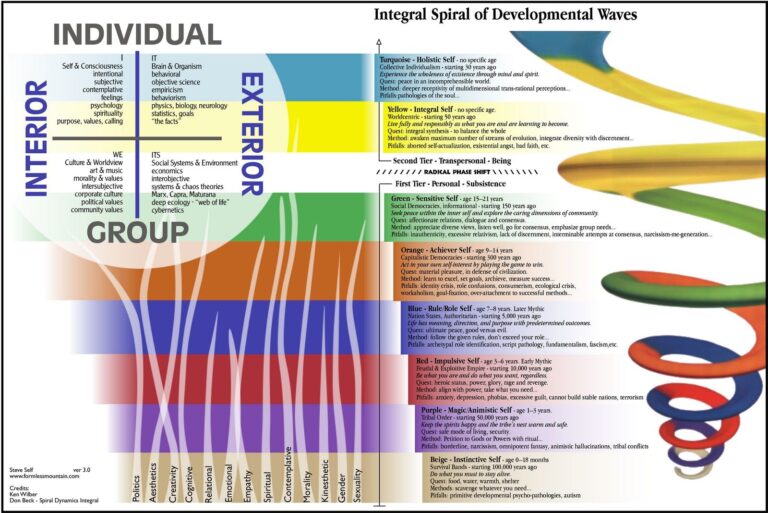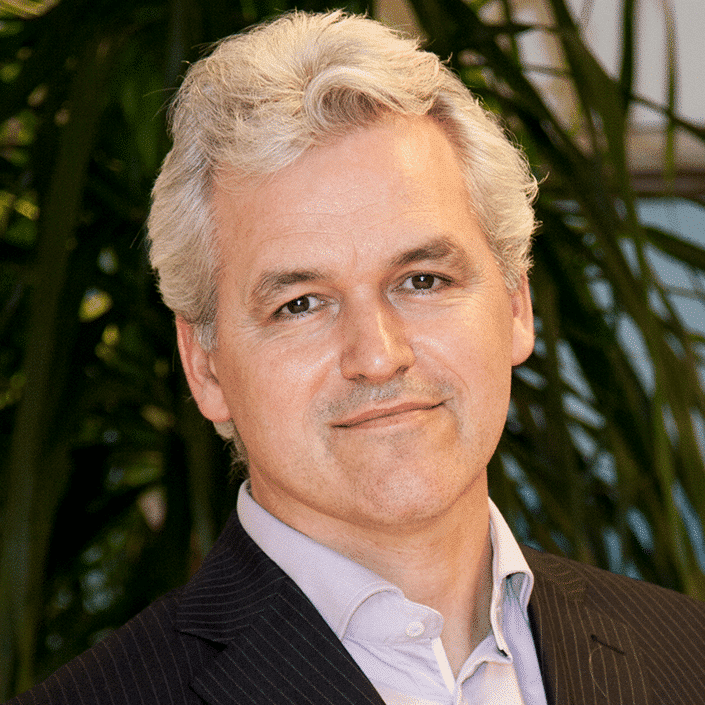In a world increasingly defined by complexity and change, understanding human development—both individually and collectively—is more vital than ever. Spiral Dynamics, a model that maps the evolution of human consciousness, offers a profound lens through which we can view these shifts. By layering Spiral Dynamics into the RoundMap framework, we unlock new insights into how individuals and organizations can grow and adapt across varied stages of awareness.
This enriched approach not only highlights the paths to progress but also reveals how each stage of development contributes uniquely to the whole. As we explore the intersections of Spiral Dynamics and RoundMap, we’ll see how embracing diverse mindsets and values can create a foundation for sustainable growth, adaptability, and shared value.
“Competency is more valued than seniority; knowledge is more useful than status.”
― Don Edward Beck, Spiral Dynamics: Mastering Values, Leadership and Change
Definitions
Wikipedia: “Spiral Dynamics (SD) is a model of the evolutionary development of individuals, organizations, and societies. It was initially developed by Don Edward Beck and Christopher Cowan based on the emergent cyclical theory of Clare W. Graves, combined with memetics as proposed by Richard Dawkins and further developed by Mihaly Csikszentmihalyi.”
NVC Consulting: “Spiral Dynamics tools, programs, consulting services, and materials are designed to help individuals and organizations understand and navigate tough “people problems.” They are based on close to 70 years of combined research, field testing, and improvements.
Overview of Spiral Dynamics
The figure below illustrates the Spiral Dynamics Integral (SDi) model, mapping the eight progressive levels of human development, beginning with the Instinctive Self and culminating in the Holistic Self. Spiral Dynamics proposes that individuals, teams, and organizations can undergo meaningful transformation, but only within specific boundaries shaped by their underlying values. These boundaries represent distinct “memes”—cultural and psychological value systems—that profoundly influence our personalities, motivations, and interactions.
Each level in the Spiral is represented by a meme-driven value system that embodies unique perspectives and priorities. These systems help explain why certain narratives or concepts resonate and catalyze change, while others fall flat. Just as these value systems drive collaboration, they can also fuel tension, as differing worldviews clash in pursuit of conflicting goals. By recognizing these eight distinct stages, Spiral Dynamics provides a nuanced roadmap for understanding why individuals and groups may align or diverge in their actions, beliefs, and visions for the future. This understanding enables us to approach change with empathy, crafting narratives and solutions that resonate across diverse developmental stages and encourage alignment toward shared goals.
Critics of Spiral Dynamics
Critics of Spiral Dynamics point to several areas of concern, ranging from the theory’s empirical basis to its application. Here’s a summary of common critiques:
1. Lack of Empirical Evidence
Critics argue that Spiral Dynamics lacks rigorous empirical validation. While Clare W. Graves, the originator of the ideas behind Spiral Dynamics, conducted research in the mid-20th century, much of this work was qualitative and anecdotal. Some academics find the model’s lack of statistical backing problematic, viewing it more as a philosophical framework than a scientifically robust developmental model.
2. Oversimplification of Human Development
The model’s color-coded stages and clear-cut levels are sometimes seen as overly simplistic, reducing the complexity of human growth into a linear or tiered structure. Critics argue that human development is more nuanced and multidimensional than Spiral Dynamics suggests, with many overlapping and dynamic factors that a single hierarchy can’t fully capture.
3. Cultural Bias and Universality
Some scholars question whether the stages outlined in Spiral Dynamics can truly apply universally across cultures. The model has been critiqued for reflecting primarily Western, individualistic perspectives, potentially sidelining other cultural understandings of development and values. This cultural bias raises questions about its applicability in diverse societies.
4. Ethical Concerns around Hierarchies
The hierarchical nature of the model, which assigns levels that imply higher or more “evolved” values, has been criticized for potentially fostering elitism. Some worry that it could lead individuals or groups at “higher” levels to view themselves as superior to those at “lower” stages. This perception could reinforce social divides, rather than fostering the compassion and inclusivity the model promotes.
5. Application in Business and Coaching
Spiral Dynamics has been popularized in organizational settings, sometimes used as a tool for personal and organizational transformation. Critics argue that it may oversimplify organizational issues and encourage a one-size-fits-all approach to management and leadership. They caution that without careful, context-sensitive application, it could lead to misguided strategies or even create a culture of exclusion for those perceived as at “lower levels.”
6. Spiritual and Esoteric Interpretations
Particularly in Spiral Dynamics Integral, popularized by Ken Wilber, there’s a merging of Graves’ ideas with Wilber’s spiritual framework. This integration, while appealing to some, has been criticized as blending empirical psychology with esoteric ideas, making the theory less accessible and further removed from its original scientific roots. Critics argue that this fusion can obscure the model’s intent and reduce its practical value.
7. Fixed Developmental Pathway
Some psychologists and developmental theorists argue that Spiral Dynamics assumes a fixed progression through levels, which may not align with real-world development. Critics suggest that human growth doesn’t always follow a predictable upward path and that people may move fluidly between values based on context, needs, or challenges rather than strictly advancing through a hierarchy.
Spiral Dynamics and RoundMap
During the creation of RoundMap, we encountered Spiral Dynamics. The concept that individuals, teams, and entire organizations undergo distinct phases of evolutionary development resonated deeply with our approach. For us, RoundMap is fundamentally evolutionary in nature, encompassing both the journey of mastery and the path to maturity. Without this evolutionary perspective, growth inevitably stagnates, and decline begins to take root.
Consider Product Development as an example: if it fails to keep pace with evolving customer demands, products quickly become obsolete, and the business loses momentum. Similarly, if competitors reduce their prices and we cannot respond due to operational inefficiencies, we risk losing valuable clientele. Growth, fueled by insights and customer feedback, is the lifeblood of evolution.
Our frameworks are designed with this evolutionary perspective in mind. While cyclical, they advance progressively over time, forming what could be seen as a spiral—a dynamic path of growth and development.
To best understand this notion of spirals as cycles that advance over time, imagine a spiral staircase: with each complete turn (a cycle of development), we ascend to a new level, a new floor. Each cycle builds upon the previous one, lifting us toward new insights, capabilities, and opportunities for sustainable growth.
The Spiral Staircase Analogy in Perspective
While the first image captures the staircase from an outside view, the concept deepens when we shift perspectives from within.
Imagine standing at the top of a spiral staircase, looking down. From this leader’s perspective, the detailed activities at the base—the frontline customer interactions—appear as a distant dot, easily overlooked. In Spiral Dynamics terms, this aligns with the Systemic Self, focused on the big picture while potentially missing critical frontline realities. Yet, those interactions are the Ultimate Level of Truth; without customer loyalty, the organization’s purpose falters.
Now consider the reverse: from the ground up, the top floor can seem remote, with leadership decisions appearing disconnected from daily challenges.
The spiral staircase metaphor captures the importance of both perspectives. Every step, from base to top, has value, and true growth comes from recognizing the significance of each. At RoundMap, we emphasize aligning vision with action across all levels, ensuring sustainable growth by connecting strategy with everyday reality.
Transitioning Through Time
When navigating change, adaptation, innovation, or transformation, it’s essential to consider every “floor” of the organization, with special attention to the ground floor—where the magic happens. All other levels exist to support and empower the work at this foundational level.
For an organization to advance—whether in groups or individually—leaders must ensure that they’re nurturing the right capabilities. In digital transformation, for instance, this means cultivating strong digital skills.
Equally important, however, is self-reflection. Leaders should look in the mirror and ask: Do I have the leadership capabilities to drive this change? Developing these skills early is vital—without them, you may find yourself facing a storm of chaos, criticism, and disarray as you attempt to lead.
Author
-
Edwin Korver is a polymath celebrated for his mastery of systems thinking and integral philosophy, particularly in intricate business transformations. His company, CROSS/SILO, embodies his unwavering belief in the interdependence of stakeholders and the pivotal role of value creation in fostering growth, complemented by the power of storytelling to convey that value. Edwin pioneered the RoundMap®, an all-encompassing business framework. He envisions a future where business harmonizes profit with compassion, common sense, and EQuitability, a vision he explores further in his forthcoming book, "Leading from the Whole."
View all posts Creator of RoundMap® | CEO, CROSS-SILO.COM



![Metallic-loft-spiral-staircase[1]](https://roundmap.com/wp-content/uploads/Metallic-loft-spiral-staircase1-768x1152.jpg)






